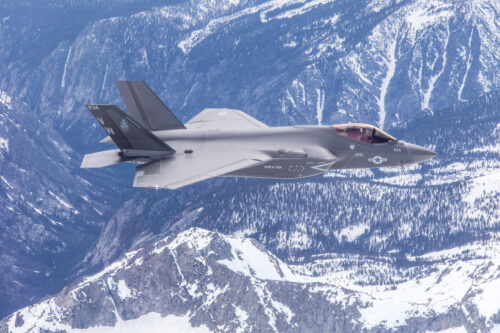In a significant development for naval aviation, the F-35C Lightning II, the U.S. Navy’s latest carrier-borne fighter, has conducted its first combat strikes. This milestone marks the F-35C’s operational debut, showcasing its capabilities in a real-world conflict.

The F-35C is a fifth-generation, long-range stealth fighter designed for the demanding carrier environment. It boasts a suite of advanced technologies, including a powerful radar, sophisticated electronic warfare systems, and the ability to carry a wide range of weaponry. These attributes enable the F-35C to perform a variety of missions, including air-to-air combat, air-to-ground strikes, reconnaissance, and electronic warfare.
The strikes, which took place on Nov. 9-10, targeted Houthi weapons storage facilities in Yemen. The facilities housed conventional weapons, including anti-ship missiles, which posed a threat to US and international vessels navigating the Red Sea and Gulf of Aden. The operation was carried out by Marine Fighter Attack Squadron (VMFA) 314, known as the “Black Knights,” assigned to Carrier Air Wing (CVW) 9 aboard the USS Abraham Lincoln (CVN 72).
VMFA-314 has a distinguished history of being the first to adopt new aircraft. They were the first Marine Corps squadron to operate the F-4 Phantom and the F-18 Hornet, and in2020, they became the first fleet squadron in both the Navy and Marine Corps to operate the F-35C. This latest achievement adds another chapter to their legacy of pioneering new technologies. In 2022, VMFA-314 made history as the first Marine Corps squadron to deploy the F-35C aboard an aircraft carrier when they embarked on the USS Abraham Lincoln.
The F-35C’s performance during the strikes was lauded by Lt. Col. Jeffrey “Wiki” Davis, commanding officer of VMFA-314. He stated, “The F-35C demonstrated its warfighting advantage by transiting contested airspace and striking targets in the heart of Houthi territory over multiple days”.
Capt. Gerald “Dutch” Tritz, commander of CVW 9, echoed this sentiment, stating, “The offensive and defensive capabilities of the F-35C enhance our air wing’s striking arm. The now battle-tested Air Wing of the Future has proven itself a game changer across all carrier air wing missions”.
The F-35C’s combat debut follows the earlier combat deployments of its sister variants. In 2018, the F-35B, designed for short takeoff and vertical landing, conducted strikes against the Taliban in Afghanistan and ISIS in Syria. The following year, Air Force F-35As carried out their first combat mission against ISIS targets in Iraq.
These initial combat operations signal a new era for naval aviation. The F-35C’s advanced capabilities, combined with the flexibility and reach of carrier strike groups, are set to reshape the maritime battlespace. As the F-35C continues to integrate into carrier air wings, its impact on future naval operations is likely to be profound.
For more information, hit the Source below